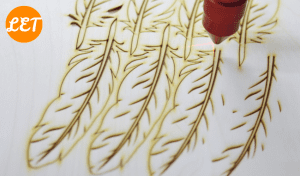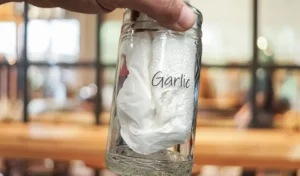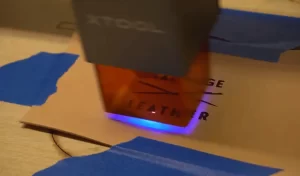Laser engraving has revolutionized how we personalize, design, and customize items. From delicate materials like paper to robust metals, laser engraving offers a versatile way to etch permanent marks with precision. But can you truly laser engrave anything?
Table of Contents
In this blog post, I will explore the many materials that can be engraved and discuss some of the most popular applications for this versatile technology. I will also provide tips on getting the best results from your laser engraving project.
What is Laser Engraving and How Does it Work?

Laser engraving is a process that uses a concentrated beam of light to etch a design onto a surface. A laser engraver, which contains a high-powered laser, generates the laser beam.
When the laser beam comes into contact with the material, it vaporizes the top layer of the material, revealing the layer beneath it. The depth of the engraving depends on the power of the laser and the amount of time it is left in one spot.
Laser engraving is a very precise process, which makes it ideal for creating detailed designs and images. It is also a relatively fast process, which means that large projects can be completed in a relatively short amount of time.
What Materials Can Be Laser Engraved?
As I mentioned earlier, almost any material can be laser engraved. Some of the most popular materials that are commonly laser engraved include:

Wood
Laser engraving on wood is popular for creating personalized gifts and home decor items. Wood is a relatively soft material, which makes it easy to engrave.
Laser engraving on wood produces a deep, clean, and permanent mark. It’s perfect for creating customized gifts, keepsakes, and souvenirs.
You will need to use a laser engraver equipped with a Diode or CO₂ laser to engrave on wood. These laser’s are ideal for engraving on wood because it can produce fine details.
Metal

Laser engraving on metal is another popular choice for creating personalized items. Metal is a durable material, so laser engraving is a great way to create long-lasting designs.
Unlike wood, metal can be difficult to engrave by hand or with an engraving pen. A laser engraver can produce clean, precise lines on metal surfaces. This makes it ideal for creating custom jewelry, nameplates, and awards.
Laser engraving on metal produces a dark, permanent mark. It’s perfect for creating customized jewelry, keepsakes, and awards.
Laser engravers equipped with fiber are the best fit to engrave on metal. This laser produces high-quality engraving on metal surfaces.
Glass

Glass is a relatively soft material, so it’s easy to engrave. However, you need to be careful when engraving glass because it can break if the laser beam is too powerful.
It’s possible to do it with an engraving pen, but getting a clean, precise result is difficult. A laser engraver can produce beautiful engraved designs on glass surfaces.
Laser engraving on glass is a beautiful way to create personalized drinking glasses, vases, picture frames, and other home decor items.
You will need to use a laser engraver equipped with a CO2 laser to engrave on glass. This laser produces a soft, frosted mark on glass surfaces. You can also use a Diode Laser but you will need to paint the surface or use transfer tape.
Stone

Stone is a very hard material, so it can be difficult to engrave by hand. A laser engraver can produce clean, precise lines on stone surfaces. This is perfect for custom engraved tombstones, pavers, and other architectural elements.
It is also great for creating personalized gifts and home decor items. Stone is a very durable material, so laser engraving is a great way to create long-lasting designs.
Just like engraving on glass, you will need to use a laser engraver equipped with a CO2 laser or a Diode laser to engrave on stone. These laser’s produces a deep, clean mark on stone surfaces.
Acrylic

This is a popular material for laser engraving because it is relatively easy to engrave, and the results are very clean. You can use a laser engraver to create custom nameplates, signs, and labels.
Laser engraving on Acrylic produces a deep, permanent mark. It’s perfect for creating customized nameplates, signs, and labels.
To engrave on acrylic, you will need to use a laser engraver equipped with a CO₂ laser or a Diode Laser. These laser’s are ideal for engraving on Acrylic because it can produce fine details. Note that you wont be able to engrave transparent Acrylic with a diode laser. You can either purchase colored acrylic or paint the surface.

Leather
Leather is a relatively soft material, so it’s easy to engrave. Laser engraving on leather is popular for creating personalized gifts and home decor items.
A laser engraver can produce intricate patterns and images on leather surfaces. This is perfect for creating custom wallets, belts, and other accessories.
Laser engraving on leather produces a deep, clean, and permanent mark on customized gifts, keepsakes, and souvenirs.
Paper

Laser engraving on paper is a popular choice for creating personalized cards, invitations, and stationery. Paper is very easy to engrave.
A laser engraver can produce intricate patterns and images on paper surfaces. This is perfect for creating custom cards, invitations, and stationery.
Laser engraving on paper produces a deep, clean, and permanent mark on customized cards, invitations, and stationery. To engrave on paper, you will need to use a laser engraver that is equipped with a CO₂ or Diode laser. These laser’s are ideal for engraving on paper because it can produce fine details.
Cardboard
Cardboard is also very easy to engrave. A laser engraver can produce intricate patterns and images on cardboard surfaces.
This is perfect for creating custom packaging, boxes, and labels. Laser engraving on cardboard produces a deep, clean, and permanent mark on customized packaging, boxes, and labels.
Cardboard is also used to make french curves and custom pencils. These are perfect for artists, designers, and other creatives.
The laser engraver that is equipped with a Diode or CO₂ laser is perfect for engraving on cardboard because it can produce fine details.
Cork
Cork is a very popular engraving substrate. It has high durability and a great contrast between dark cork and light engraving.
Cork is a popular material for laser engraving because it is relatively easy to engrave, and the results are very clean. You can use a laser engraver to create custom nameplates, signs, and labels.
Stainless Steel

You can engrave stainless steel. However, you have to use the right techniques to protect its corrosion resistance.
Laser engraving on stainless steel is popular for industrial use, but there are a few things to keep in mind. First, you need to use the right type of laser. Second, you need to protect the stainless steel from corrosion.
Stainless steel is a popular material for laser engraving because it is very durable. Laser engraving on stainless steel produces a deep, clean, and permanent mark on customized products.
You will need to use a laser engraver equipped with a fiber laser to engrave on stainless steel. This laser is ideal for engraving on stainless steel because it can produce fine details. For a more cost effective option then some high end Diode Laser’s will also get the job done.
You will also need to protect the stainless steel from corrosion by coating it with a thin layer of oil before engraving. This will help to prevent the formation of rust on the stainless steel surface.
Materials You May Not Laser Engrave
Although you can laser engrave on various materials, there are some materials you should not try to engrave. Some examples of materials you should not laser engrave include:
Thick Polycarbonate/Lexan
Polycarbonate is a clear plastic that is often used in bulletproof glass. It is very thick and difficult to engrave. You will have a very poor cut; it may discolor or even catch fire.
Flammable Materials
You should never try to laser engrave flammable materials. The laser engraver will produce a lot of heat, which can cause the material to catch fire. Some examples of flammable materials include:
- Polystyrene foam
- Polypropylene foam
- Milk bottle plastic
How to Get Started with Laser Engraving
Now that you know what materials you can laser engrave, you’re ready to get started. Here are a few tips to help you get started with laser engraving:
Choose the Right Laser Engraver

Not all laser engravers are created equal. You will need to choose a laser engraver that is powerful enough to engrave the material you want to use.
If you’re unsure which laser engraver is right for you, then check our our buying guides. They will be able to help you choose the right laser engraver for your needs.
Create a Design
Once you have chosen a laser engraver, it’s time to create a design. Plenty of resources are available online if you’re unsure how to get started. You can find free design software, templates, and tutorials.
If you’re unsure where to start, try looking for a design similar to what you want to create. This will give you a good starting point.
Engrave Your Design
This process requires you to choose the right settings for your laser engraver. The settings will depend on the type of material you’re engraving and the design itself.
It’s important to test the settings on a scrap piece of material before engraving your final design. This will help you avoid any mistakes.
How To Choose the Right Laser for Your Needs
Here are a few factors to consider when choosing the right laser for your needs:
Material
As I discussed above, different materials require different lasers to produce the best results. Make sure to choose a laser compatible with the material you want to engrave.
Power
The power of the laser is measured in watts (W). A higher wattage laser will be able to engrave faster and deeper than a lower wattage laser.
Beam Quality
The beam quality of the laser is measured in microns (µm). A higher quality laser will have a smaller beam, which produces cleaner, more precise engraving.
You also need to consider the size of the area you want to engrave. You can choose a lower-wattage laser if you only need to engrave small areas. However, if you need to engrave large areas, you will need a higher wattage laser.
Some Popular Designs That Are Laser Engraved

Here are some popular designs that people often laser engrave:
Logos
You can use laser engraving to create a professional-looking logo. This is a great way to promote your business or brand.
Images
Laser engraving is a great way to add images to your products. You can use photos, illustrations, or even hand-drawn images.
Text
Laser engraving is a great way to add text to your products. You can use any font you want, and the engraving will be very precise.
QR Codes
You can use laser engraving to create QR codes. This is a great way to add digital information to your products.
Frequently Asked Questions
Can you laser engrave metal?
Yes, you can laser engrave metal. However, the results will vary depending on the type of metal. Some metals are easier to engrave than others.
Is laser engraving permanent?
Yes, laser engraving is a permanent process. Once the design is engraved into the material, it cannot be removed.
Is laser engraving or hand carving better?
It depends on what you’re trying to achieve. Laser engraving is the better option if you want a more precise engraving. Hand carving is the better option if you’re looking for a more rustic look.
Final Thoughts
Laser engraving is a great way to add personalization to your products. You can engrave many different materials, and the possibilities are endless. Just be sure to choose the right laser for your needs, and always test the settings on a scrap piece of material before engraving your final design. Thanks for reading. I hope this has been helpful.
